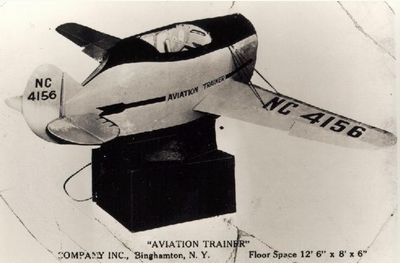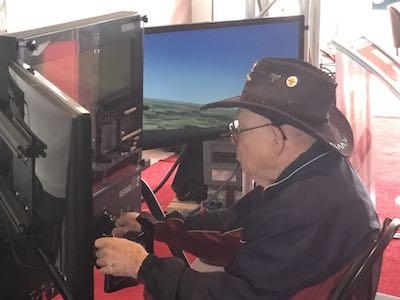Where Are We Now And How Far Will It Go?
By: Gary Risley
Flight simulators have long been used by the military and scheduled air carriers in training their pilots. Going back to the vertigo-inducing Link trainer, Frasca's early patent that allowed them to dominate the market for many years, and the early electro-mechanical monsters used by the airlines when it became too expensive to train pilots in the aircraft, ways are sought to reduce the cost of pilot training and to increase pilot skills and proficiency.

While simulators have been available at the professional level for many years, availability to general aviation pilots has been slim. Over the years, many flight training schools had physical mockups of their cockpits to allow familiarization with the aircraft configuration, some had IFR electromechanical training devices that allowed limited hours to be credited to the instrument rating, but overall development of simulators for the training of general aviation pilots was unavailable until advancements of the personal computer and the proliferation of cheap memory and processing power made it possible.
Many general aviation pilots started off with the original Microsoft Flight Simulator with its green stick figures and ghostly outlines flown off the keyboard or a two dollar joystick. Today there are many very good PC-based home flight simulators, but the time flown on these programs cannot be credited for flight training or the currency. Are there current opportunities to substitute flight time with computer simulator time, and what does the future hold with regard to flight simulation for the non-professional pilot?
Redbird Flight Simulations and Alsim are two flight simulator companies whose products include simulators used for primary and instrument training. Discussions with marketing representatives of each of the companies revealed a remarkably consistent view as to the benefits of flight simulation and methodology: higher quality training, increased safety, and retention of information by the student.

Ethan Willinger, marketing manager for Redbird, explained that the Redbird product line includes the TD and TD2 desktop flight simulators. These simulators are now certified for use to maintain instrument currency by instrument-rated pilots without an instructor being present and without flying the actual aircraft. The simulator can also be used for primary flight training and instrument students for familiarization purposes, but hours available for credit towards mandatory flight time are limited by regulation. The $8000 list price product can be placed or mounted on a tabletop and includes three monitors. The controls are not control-loaded but the visuals and controls do allow the student to practice both visual patterns and instrument approaches. Redbird also offers numerous other simulators, including motion-based simulators, to be used in higher certificate-level and type rating training.

Alsim produces simulators that are used by numerous flight schools and universities around the country. While they offer a generic flight simulator, the majority of their products sold are based upon the particular aircraft configurations requested by their customers. The simulators are non-motion-based but feature high definition projection on three large screens in a closed box with control-loading yoke and rudders along with an instructor station behind the cockpit. The simulator can be used to introduce students to the training aircraft prior to actual flight and provides a realistic sense of flight including a sense of motion based upon the improved visuals. Mike Tonkin, global business development director, noted that over 80 percent of the sensation of motion is visual, so excellent visuals create a realistic experience for the student. The writer flew a pattern in a Cessna 172 simulator, and the control loading and the visuals were very good.
Each company emphasized that the quality of training directly impacts the end product. In that light, each company is now producing non-sim training products that may be utilized by their respective customers, or, in the case of Redbird, may be purchased by consumers to be used for primary and instrument training.
Each company argued that the students will retain more if they go through the practice exercises in the simulator prior to flying in the airplane. Tonkin stated that their research showed that students who take their initial training straight in the aircraft retain approximately five minutes of instruction for each training hour; particularly, in the initial phases. Students who train first in the simulator retain about 45 minutes of the hour of instruction due to the lower stress levels and lack of distractions. Even though most simulator hours may not be logged under US regulations, the time spent in the simulator prior to flying the aircraft reduces significantly the amount of time it takes to solo and achieve the desired certificate. In an environment where the cost of the aircraft is a significant portion of training cost, simulators may serve to reduce the overall cost of obtaining a pilot certificate.
Think you are too old to learn to fly a flight simulator? Meet Jack Scoggins, age 88, active pilot, CFII, and former designated pilot examiner. Scoggins is a retired Air Force Colonel who learned to fly in 1950 while in college, went into the military where he retired, then began a career of flight instruction.

Mr. Scoggins (pictured) was observed flying the Redbird TD2 simulator at Oshkosh. Scoggins stated that he had been utilizing flight simulators in the instruction of his students for a number of years. He found that his current simulator reduces the amount of time instruction for students in the aircraft, he can introduce the student to procedures that might not be safe to perform in the aircraft, and that it leads to a reduced overall cost to his students. He found that it is a tool for faster learning for students, they are more relaxed, and retain more using the flight simulator prior to flight in the airplane.
Scott Firsing, sales and business development director for Alsim in the Americas, also noted that simulators are an excellent tool to enhance ground school training. Rather than a dry textbook and mere conceptual teaching regarding flight procedures and techniques, exposure to a flight simulator while going through ground school expedites the learning process and aids in comprehension and retention.
As to the future? There does not appear to be a flight simulator industrial group to advocate for the allowance of increased credit toward mandatory flight hours related to the use of simulators. Data is being collected through the companies’ customers as to the effectiveness of the training system, and each of the two companies believes that submission of this data to the federal regulators will result in more time being credited toward mandatory flight times than is allowed under the current regulations. Each company declined to speculate as to when or where such changes might occur.
One can expect that as computer technology continues to advance that the price simulators will drop and the capabilities will increase. Microsoft Flight Simulator and X-Plane have advanced significantly the consumer products flight simulation available to the general public, and they provide a reasonable facsimile of airplane flight for the price of the product but they are not eligible for certification. The professional flight simulation products, appropriately, are much better than the over-the-counter products and are certified. Availability of systems should increase in smaller communities as prices drop.
As professional flight simulators continue to improve, one can only anticipate that federal regulators will have to recognize the benefit of these training devices in the near future and allow more hours to be logged towards flight certification. The data and results will demand it.
(Images Provided By Author)
 ANN's Daily Aero-Term (04.30.24): Runway Centerline Lighting
ANN's Daily Aero-Term (04.30.24): Runway Centerline Lighting ANN's Daily Aero-Linx (04.30.24)
ANN's Daily Aero-Linx (04.30.24) Airborne 04.24.24: INTEGRAL E, Elixir USA, M700 RVSM
Airborne 04.24.24: INTEGRAL E, Elixir USA, M700 RVSM Airborne 04.29.24: EAA B-25 Rides, Textron 2024, G700 Deliveries
Airborne 04.29.24: EAA B-25 Rides, Textron 2024, G700 Deliveries Airborne-NextGen 04.23.24: UAVOS UVH 170, magni650 Engine, World eVTOL Directory
Airborne-NextGen 04.23.24: UAVOS UVH 170, magni650 Engine, World eVTOL Directory






